- Kinari Webb has a superpower: the ability to provide high-quality health care in a remote and rural landscape.
- And she uses her power not only to save lives, but also to protect the remaining Bornean rainforests.
- Twenty-one years ago, Kinari Webb traveled to Borneo to work with orangutans.
Innovation in Tropical Forest Conservation: Q&A with Dr. Kinari Webb
Dr. Kinari Webb has a superpower: the ability to provide high-quality health care in a remote and rural landscape. And she uses her power not only to save lives, but also to protect the remaining Bornean rainforests.
Twenty-one years ago, Kinari Webb traveled to Borneo to work with orangutans. She witnessed the faltering health of both the people and the environment and saw that the two issues were inseparable. When families must choose between the health of their children and the health of the forest that supports them, everyone loses. But in the region of Gunung Palung National Park — where an estimated 10 percent of the world’s orangutans live — illegal logging and slash and burn farming methods paid the bills and locals saw few alternatives. Kinari vowed to study medicine and return with more to offer.
After graduating from Yale University’s School of Medicine with honors and completing her residency in California, she kept her pledge. Launching the non-profit organization Health In Harmony in 2006, she opened a health clinic on the border of Gunung Palung National Park.
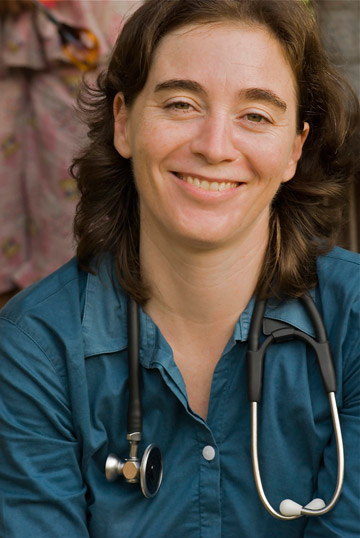 Kinari Webb, MD. Photo by Erick Danzer. |
Kinari told mongabay.com, “During the first year of the clinic’s operation we held over 400 hours of community meetings asking a simple question: ‘You all are guardians of a precious resource which is valuable to the whole world. If the world community was willing to partner with you to help save this rainforest, what would you need in order to be able to stop logging?’ Unexpectedly, there was near consensus in the bordering communities: affordable, high quality health care including mobile clinics and ambulance services and training in organic farming methods.”
Health In Harmony trades health care and training in farming methods for forest protection. Care at the clinic is not free, patients can pay via “non-cash means” such as seedlings for reforestation projects, volunteer work, or other goods oriented towards protecting local ecosystems. Donations (mostly from Western donors) make up the remainder of the costs. No one is turned away due to lack of payment.
“In the first five years of our program,” Kinari said, “we saw a 68 percent decrease in illegal logging households. In addition to the majority of previous loggers switching to farming, health indicators saw near universal improvement, including an 18 percent decline in infant mortality and a tripling of income (from a 2003 baseline of $13 per month).”
With its approach yielding success, Health in Harmony is establishing that win-win solutions are more than a possibility, they are a necessity. Kinari’s work has been profiled in Oprah Magazine, PBS’s News Hour with Jim Lehrer, National Geographic, the Sierra Club, four Indonesian TV channels, Tempo Magazine, Kompas Newspaper and the Voice of America.
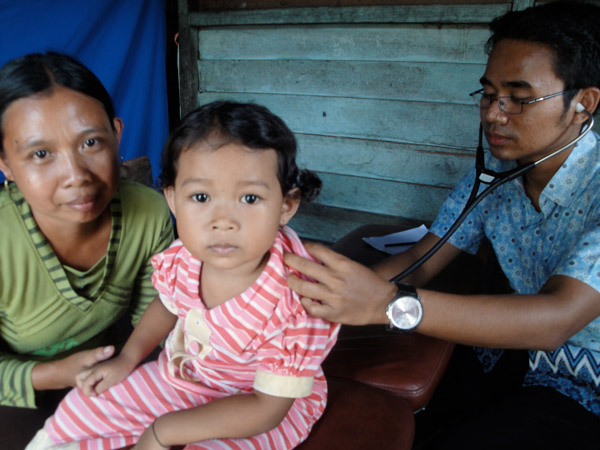
Family receives care at Mobile Clinic. Photo by Lauren Tobias.
AN INTERVIEW WITH KINARI WEBB
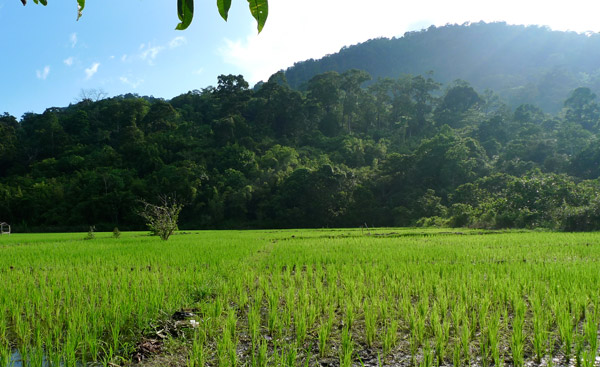
Farm in front of the forest. Photo by Kinari Webb.
Mongabay: What is your background?
Kinari Webb: I first visited Borneo in 1993, while taking a year off from my undergrad at Reed College. Living in Gunung Palung National Park, I observed far more than orangutans and the deforestation that threatened their livelihood; I came for the first time to really know material poverty and simultaneous wealth of community. The latter demonstrated to me the potential that lives in us all to contribute – to work towards a healthier, more balanced society. After much reflection, I decided to attend medical school, always knowing that I would want to address a more holistic kind of health that recognizes how interconnected we are with the natural world.
I attended Yale School of Medicine and completed my residency at Contra Costa Regional Medical Center in Martinez, CA. After founding our non-profit, Health In Harmony, my husband Cam Webb (a tropical botanist) and I returned to Indonesia. I then spent a year traveling around Indonesia searching for a location that had simultaneously threatened but salvageable rain forest (surprisingly hard to find), health care needs (nearly ubiquitous), and government support (variable). What I found in that year was how common — if not universal — it was for human well-being to be tightly linked to environmental issues such as mercury from small scale gold-mining, or logging, and how common it was for people to site needing to pay for health care as a reason for overexploiting the environment.
Curiously, the spot where we ended up starting the program in 2006 bordered the park I had lived in in 1993 —home to roughly 10 percent of the world’s remaining orangutans and with arguably the highest biodiversity of any national park in Indonesia.
Mongabay: How long have you worked in tropical forest conservation and in what geographies? What is the focus of your work?
Kinari Webb: By mid 2007, we had completed a baseline survey of almost 1400 households (estimated total population around the park is 60,000 people) and opened a clinic where patients had the option of paying via non-cash means that were oriented towards preserving and restoring the rainforest.
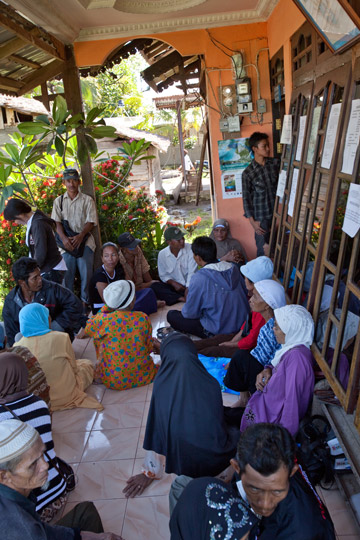 Clinic porch as overflow waiting area: Photo by Chris Beauchamp. |
Then during the first year of the clinic’s operation we held over 400 hours of community meetings asking a simple question: “You all are guardians of a precious resource which is valuable to the whole world. If the world community was willing to partner with you to help save this rain forest, what would you need in order to be able to stop logging?”
Unexpectedly, there was near consensus in the bordering communities: affordable, high quality health care including mobile clinics and ambulance services and training in organic farming methods.
The former was motivated by an understanding of something I’ve already mentioned: the antagonism between communities and their environment, driven by the need to raise income to pay for health care. The reason for the second request was summarized by one village elder, “Our traditional method of growing rice with shifting agriculture worked well when there was lots of forest and not many people, but it doesn’t work anymore. We heard there was a way to grow things in one place without expensive chemical fertilizers, but we don’t know what it is, will you teach us?”
The wisdom of these requests has been borne out over the years: in the first five years of our program we saw a 68 percent decrease in illegal logging households. In addition to the majority of previous loggers switching to farming, health indicators saw near universal improvement, including an 18 percent decline in infant mortality and a tripling of income (from a 2003 baseline of $13 per month).
Mongabay: Are you personally involved in any projects or research that represent emerging innovation in tropical forest conservation?
Kinari Webb: I’m always struck by the extent to which my work as both a doctor and a conservationist is seen as innovative in the West – in the communities that I have called home for nearly a decade, the intersectionality of human and environmental health is a given. It begins with people forced to destroy ecosystems to make money to pay for health care, and continues into the positive feedback loop of environmental destruction: flooding and droughts from deforestation, mercury accumulation in fish, increases in malaria in logged forest, and fires, can all negatively impact human health.
Our model at Health In Harmony is to break that destructive cycle, by working with communities to determine what they would need to protect their ecosystems, making sure they can always access the things they need, but also rewarding communities that are protecting the forest. We do this by having part of patients’ bills from non-logging villages paid for by people who care about protecting rain forest (our mostly Western donors). The local communities love this system as it honors their dignity and the fact that they have something valuable to trade with the world community. In return they get things that no amount of money could buy previous to our program’s establishment: excellent quality health care and training in organic farming methods.
We provide those things by bringing in outside experts who train locals. The experts in sustainable agriculture come from Java and doctors from top universities in the US volunteer to teach the young Indonesian doctors who provide very high quality care.
Mongabay: What do you see at the next big idea or emerging innovation in tropical forest conservation? And why?
Kinari Webb:
The world is currently confronting crises of many kinds: massive population growth, loss of biodiversity and extreme income inequality. I am inspired by the growing awareness of the interconnectedness of these crises and the number of great organizations that are working on this.
But what gives me the most hope is the growing interconnectedness of people; it is a constant source of amazement and growing source of hope to me that almost every village on the planet has a cell phone today.
That fact, in and of itself, will not solve many problems. But it certainly allows for the possibility of setting up a system of true bottom-up driven development that is done in a way that protects the natural environment. My experience is that most rural communities are intensely aware of how critical it is to protect the health of their local ecosystems and know what the best development solutions would be, so that both the environment and people benefit. The problem is that local people are generally disenfranchised and not given the central position in decision-making. I see huge possibilities in coupling this interconnectedness and indigenous knowledge with technological and material surpluses elsewhere in order to address the roots of both poverty and environmental destruction.
Mongabay: What are the obstacles/challenges to spreading the model of Health In Harmony to other regions?
Kinari Webb: Honestly, we can’t know until we try, but besides that, I’d say three things: funding, staff and time.
Despite Health In Harmony’s demonstrated success in conservation that simultaneously raises household income and improves human health (and therefore conservation that maximizes impact for every donor dollar), funding is always an issue. REDD+ proceeds may offer a viable option and is one we have explored but there are many barriers for its potential to be fully realized.
Regarding staff — although we have already trained many people who are interested in replication, finding folks willing to work in remote areas and make the long term commitment that Health In Harmony values (so as to maximize institutional memory and to guarantee that work is being done with a high degree of relevance and sensitivity) is difficult. I will say that our staff in Sukadana ,who have been with us for many years, express a lot of gratitude for the joys afforded by small, rural communities and getting to make a big difference. But it is a matter of getting over that initial activation energy, so to speak.
Time presents perhaps the greatest challenge — the clock is running out on biodiversity. Health In Harmony would never be able to replicate enough times, fast enough. Thinking creatively about how to spread the model and encourage others to act with our core values of radical listening and integrated human and environmental health is thus critical.
In terms of where we plan to replicate, the first place we would like to do is Raja Ampat. This part of Indonesia has the highest marine biodiversity in the world and a parallel (and unacceptable) infant mortality rate of 20 percent. Communities talk often about feeling coerced into exploiting both the coral reefs and the forest in order to pay for health care even though they know their long-term well being is based on a healthy environment — one medical emergency costs a family more than a year’s income and forces people into unsustainable practices including bombing coral reefs, and over-fishing (it takes a shocking 440 pounds of dried sea cucumbers to cover just the $200 for transport to and accommodation at a health care facility).
I believe that no community should ever be forced into an antagonistic relationship with the natural environment to get their basic needs met (as is the case in Raja Ampat). When people like this lose, the whole world loses.
Mongabay: How could these challenges be overcome?
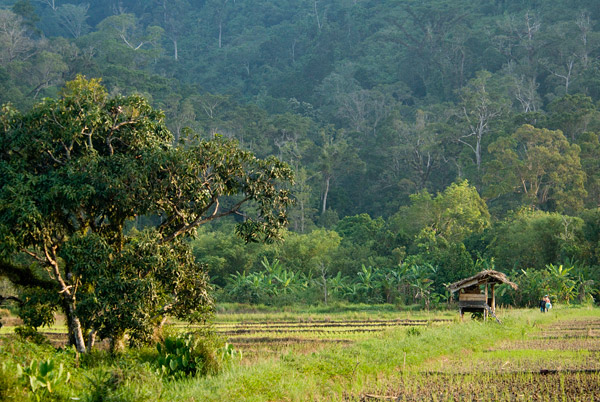
Farm bordering the National Park. Photo by Erick Danzer.
Kinari Webb: Presenting conservation funders and organizations with an increasingly sophisticated narrative about the success holistic models offer, certainly offers some potential relief to the challenge of funding. It seems intuitive to us that the most effective way to protect and restore ecosystems would be to elicit the most passionate buy-in from resident communities, but holistic mindsets are hard to come by in a world that exerts pressure on funders to be narrow in their scope and goals.
Maximizing the quality of health care is integral to this mission also; the Health In Harmony model hinges upon the concept that better human health is axiomatic to better environmental health and vice versa. But for that to work, you actually have to improve access to high quality health care.
At Health In Harmony we create an opportunity for volunteer physicians from the West to come and train young local doctors. We have been surprised by what a large stream of physicians in the Global North are ready and willing to fulfill this purpose in Kalimantan, and we can only imagine the crowds that might respond to a “diving doctors needed” solicitation for Raja Ampat. To be clear though — the world class nature of the care we provide is not the product solely of Western medical expertise – it’s in integrating Western and indigenous knowledge that our Indonesian doctors achieve the greatest, most compassionate outcomes.
We believe with the right funders who have a holistic perspective, the right people who are passionate about both human and environmental well being, and creative ways to spread the Health In Harmony model, critical ecosystems all over the planet could be saved and the well being of the communities around them dramatically improved. This is true win-win and we hope we can help make it happen.
Mongabay: In regards to conservation, is there anything you feel is NOT working (or not working well) that continues to get a lot of attention and support?
Kinari Webb: I see a lot of lip service being given to the idea that local communities need to be included in the equation when considering protecting natural resources but rarely do I see that done in a truly meaningful way. I also see programs talking about community participation but they do not do what I call radical listening: trusting the communities to KNOW what the most critical fulcrums for change are, and trusting that they understand best how to solve those problems — even when the reasons behind those suggestions are opaque to outsiders.
Sometimes when I have given the advice to programs to let the local communities design the programs, I have been scoffed at, “These are poor, uneducated people, how can they possibly know?” But no one knows better what the solutions to their own problems are, than the people experiencing them. It is also very difficult to get anyone to do something they haven’t already decided they want to do.
I recognize that this kind of approach requires a change in mind-set both from conservation programs and from funders but our experience is that when the local communities drive the solutions, we will end up with greater protection of natural habitats and a more just and equitable world.